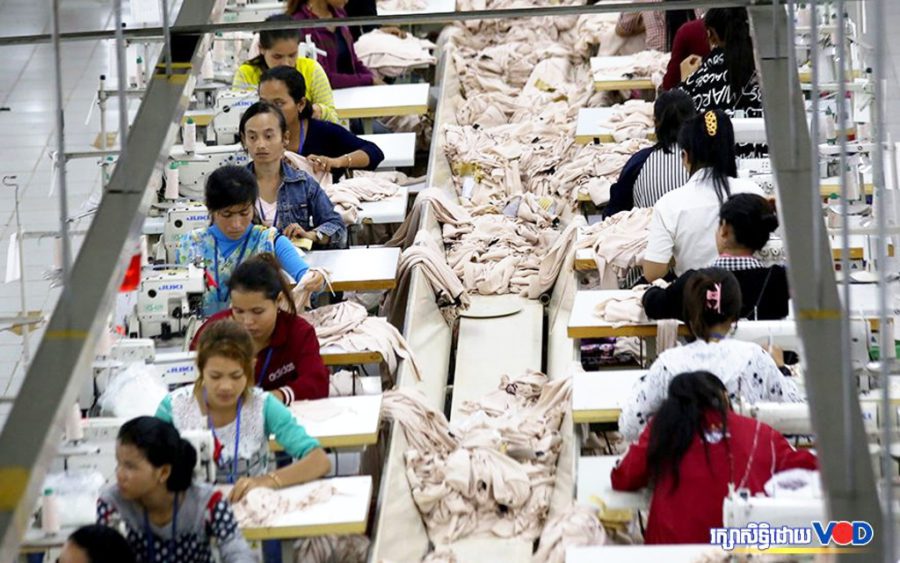A new study on the hardships of garment workers during the pandemic has called for a “living wage” more than triple the current minimum pay rate for the Cambodian garment industry.
The report published earlier this month by the Australian office of non-governmental organization ActionAid, a global women’s rights group, focused on both Cambodia and Bangladesh and included results from a survey of more than 200 garment workers divided almost equally between the two countries.
In both its survey data and personal accounts of individual Cambodian workers, the report largely echoed findings from other studies of garment labor during the worst of the pandemic, when Covid-19 battered global supply chains and temporarily suspended many of Cambodia’s producers. But this most recent study appears to go a step further than others in its recommendations to rebuild the industry with an urge that the Cambodian garment industry adopt a “living wage” for garment workers of $588 per month — more than triple the current minimum wage of $192.
The report notes the proposed living wage was calculated in 2020 by Asia Floor Wage Alliance (AFWA), a regional labor coalition advocating for higher wages across the continent.
Ou Sopheary, the research head of ActionAid Cambodia, said she was surprised by the number of Cambodian garment workers who told the survey team they’d experienced hunger as a result of pandemic closures. Despite that, Sopheary said negotiations over wages in the garment sector don’t come close to the sum proposed as a living wage.
“It is interesting to me that unions didn’t use AFWA research as a basis for their advocacy. For them, they have no hope that the Cambodian government can respond to them with that ideal wage,” she said. “Instead, they conducted another study utilizing the government statistics and considered factors such as growth in the garment industry, inflation, social, productivity and FDI competitiveness, hoping that the proposed wage will be closer to what the government can offer. Yet still, the government rejected their request.”
Labor representatives, industry advocates and government officials conduct an annual series of three-way negotiations to set a minimum wage for garment workers.
By the end of this year’s round of talks in September, the government approved a $2 wage increase for 2022. Workers’ representatives had requested a raise of $12, while the employers’ bloc asked for a cut of $16.
This month’s ActionAid report also cited AFWA calculations for a Bangladeshi living wage of about $561. The wage alliance’s website states these wage estimates are based on purchasing power parity and food basket research.
In Cambodia, Sopheary’s research team surveyed 118 garment workers from six different factories. Of those people, 35 percent said their income was insufficient to cover daily expenses with 47 percent responding that they’d had to take on additional loans to cover household expenses. Overall, 89 percent respondents said their household had run out of money to buy food at some point during the pandemic.
But Ken Loo, spokesperson of the industry group Garment Manufacturers Association of Cambodia, dismissed the findings of the report altogether, calling the proposed wage increase “crazy.”
Loo maintained that certain findings of the report, mainly that garment workers had faced increased hunger due to lack of money, were the result of poor spending habits — not any shortcoming of the industry.
“I don’t really understand the fixation on minimum wage. It’s a minimum floor that the government mandates, it doesn’t reflect the wages that the workers are receiving, it doesn’t prevent them from getting more than that,” Loo said, listing what he described as a theoretical household budget for a worker. “That’s surely sufficient to meet your basic needs foodwise, housing-wise, transportation-wise. You might not have enough left over savings, but your basic needs are more than met.”
AFWA defines a living wage as one earned over a maximum work week of 48 hours and is sufficient to meet the basic needs of workers and their families while providing some discretionary income. The AFWA definition also requires the wage to exclude any additional bonuses, overtime pay or benefits, and be enough to cover the basic needs — including costs of housing, food, education and healthcare — of a family of four, defined as two parents and as many children.
The ActionAid report calls for all workers in the garment supply chain to receive such a wage and calls on Australian brands, as well as the governments of the two countries studied, to take steps to make that happen.
The report also specifically calls on Australian brands to negotiate directly with unions to make agreements regarding compensation and benefits for laborers whose work was disrupted by the pandemic. But the “number one recommendation” from the report, according to Sopheary, is for brands to publish and maintain a complete list of their supplier factories, including subcontractors.
“With this information, we can hold the brands accountable. Because, often when we make a complaint to brands, they always claim that they have no contractual relationship with the violated factory even though we have all the evidence,” she said. “[As] one of the female garment workers we interviewed said, the brands should do as they say when they claim that they are respecting and promoting women’s labour rights.”













